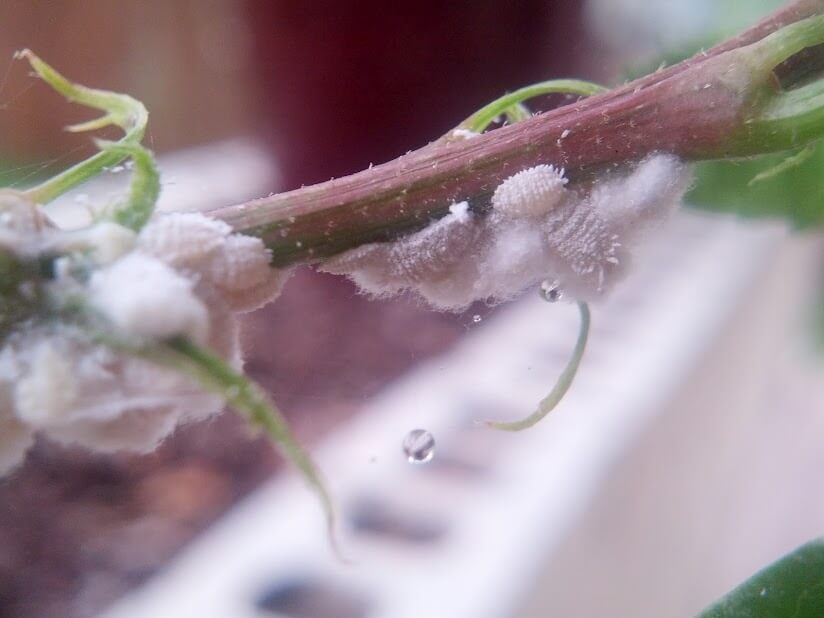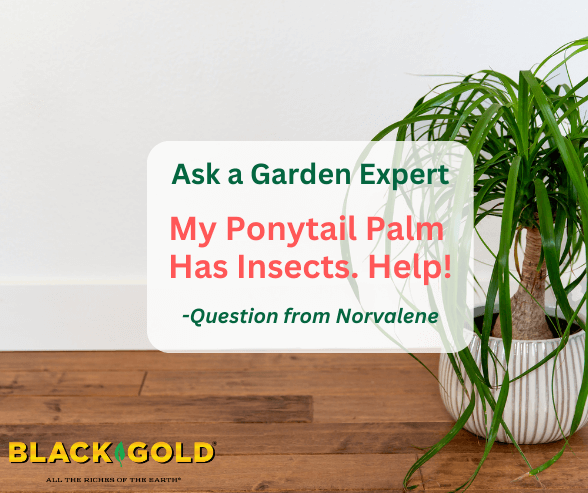“My ponytail plant has insects in it. How do I replant it, and can I sit it in water?” Question from Norvaline from
Dear Norvalene,
Ponytail palms (Beaucarnea recurvata) like dry conditions, so do not sit yours in water. They are typically easy to grow, but on occasion, they get tiny mites on the foliage or other insects, such as mealy bugs, scale, or earwigs, down in the cracks between the leaves. I have a couple of recommendations for ways to remove any unwanted insect pests. Mealybugs are the most common problem. Please read the following to learn how to manage them. You can use the same techniques to manage scale and mites. The excerpt is followed by instructions for replanting and caring for ponytail palms.
How To Manage Mealybugs
Here is an excerpt from my blog, Managing the Worst House Plant Pests:
Mealybugs are soft, white, and feed on the juices of plant leaves and stems, particularly in the crevices between leaves and stems. Mealybug infestations are hard to manage because these pests travel and spread as crawlers. Crawlers are the nearly invisible nymphs that hatch from the pest’s white, cottony egg masses and “crawl” several feet to quickly infest other plants. You can’t always see these crawlers, so to manage them, you have to clean plants, containers, and surrounding surfaces when you see an infestation. They produce copious crawlers, so the sooner you notice mealybugs, the better.

To remove mealybugs, start by cleaning your plant, its pot, and all surfaces surrounding the plant. Remove the top two inches of potting soil and replace it with fresh. Finally, spray the plants. One of the best mealybug sprays is a 10-25% solution of isopropyl alcohol. Fill a spray bottle with 1/4 cup of isopropyl alcohol and 2/4 cup water and shake to combine. When treating plants with this solution, keep them out of direct sunlight because it can cause leaf burn in the bright sun. You can also treat plants with insecticidal soap or Neem oil. Repeat spray treatments until plants are mealybug-free.
Another method to stop crawlers is to surround infected areas with double-sided tape traps. As the crawlers hatch and begin crawling, they will get stuck on the tape and die. You can also surround plant bases and pot edges with double-sided tape to keep crawlers from moving beyond an infected plant.
Ponytail Palm Replanting and Care
Ponytail palms are technically succulents. The bulbous base of the plant holds water like a succulent, and they like drier soil, so provide a fast-draining potting mix, such as Black Gold® Natural & Organic Succulent & Cactus Potting Mix. To replant yours, plant it in a pot slightly larger than the one it’s currently in, and make sure the container has large drainage holes to further encourage drainage.
When replanting, I generally place a layer of fresh soil in the bottom of the pot. Your goal should be to have at least 1 inch of space at the top of the pot for watering after replanting. Remove the plant from the old pot and make sure its roots are not densely intertwined or pot-bound. If they are, gently tease them apart along the edges before planting. Next, center the plant in the new pot, and then work soil around the edges, packing it down gently with your fingers until the root ball is covered. (Please click here to watch the following video to learn more about transplanting.)
Be sure not to overwater the plant. I typically water mine once weekly during the winter months and twice weekly in summer when I take my plant outside.
Happy gardening!
Jessie Keith


